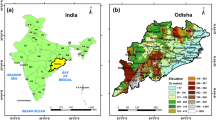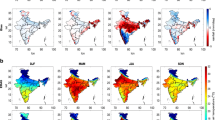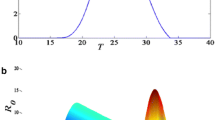Abstract
Malaria is a critical health issue across the world and especially in Africa. Studies based on dynamical models helped to understand inter-linkages between this illness and climate. In this study, we evaluated the ability of the VECTRI community vector malaria model to simulate the spread of malaria in Cameroon using rainfall and temperature data from FEWS-ARC2 and ERA-interim, respectively. In addition, we simulated the model using five results of the dynamical downscaling of the regional climate model RCA4 within two time frames named near future (2035–2065) and far future (2071–2100), aiming to explore the potential effects of global warming on the malaria propagation over Cameroon. The evaluated metrics include the risk maps of the entomological inoculation rate (EIR) and the parasite ratio (PR). During the historical period (1985–2005), the model satisfactorily reproduces the observed PR and EIR. Results of projections reveal that under global warming, heterogeneous changes feature the study area, with localized increases or decreases in PR and EIR. As the level of radiative forcing increases (from 2.6 to 8.5 W.m−2), the magnitude of change in PR and EIR also gradually intensifies. The occurrence of transmission peaks is projected in the temperature range of 26–28 °C. Moreover, PR and EIR vary depending on the three agro-climatic regions of the study area. VECTRI still needs to integrate other aspects of disease transmission, such as population mobility and intervention strategies, in order to be more relevant to support actions of decision-makers and policy makers.









Similar content being viewed by others
Data availability
RCA4 output data are available through the Earth System Grid Federation (ESGF) website (https://esgf-data.dkrz.de/search/cordex-dkrz/). The ERA‐Interim reanalysis is available from the European Centre for Medium‐Range Weather Forecast (ECMWF) and can be downloaded through the link: https://apps.ecmwf.int/datasets/data/interim-full-daily/levtype=sfc/. The CHIRPS2 data are available at https://data.chc.ucsb.edu/products/CHIRPS-2.0/global_daily/netcdf/.
References
Abiodun GJ, Witbooi P, Okosun KO (2018) Modelling the impact of climatic variables on malaria transmission. Hacettepe J. Math Stat 47:219–235. https://doi.org/10.15672/HJMS.2017.452
Asare EO, Amekudzi LK (2017) Assessing climate driven malaria variability in Ghana using a regional scale dynamical model. Climate 5(1):20. https://doi.org/10.3390/cli5010020
Ayanlade A, Sergi C, Ayanlade OS (2020) (2020) Malaria and meningitis under climate change: initial assessment of climate information service in Nigeria. Meteorol Appl 27:e1953. https://doi.org/10.1002/met.1953
Bandolo FMN (2012) Heavily indebted poor countries (HIPC) initiative in cameroon and the fight to reduce malaria related under-five mortality (Master's thesis, Høgskolen i Oslo og Akershus. Fakultet for samfunnsfag). https://hdl.handle.net/10642/1803
Bayoh MN, Lindsay SW (2003) Effect of temperature on the development of the aquatic stages of Anopheles gambiae sensu stricto (Diptera: Culicidae). Bull Entomol Res 93(5):375–381. https://doi.org/10.1079/BER2003259
Béguin A, Hales S, Rocklöv J, Åström C, Louis VR, Sauerborn R (2011) The opposing effects of climate change and socio-economic development on the global distribution of malaria. Glob Environ Chang 21(4):1209–1214. https://doi.org/10.1079/BER2003259
Bentsen M, Bethke I, Debernard J, Iversen T, Kirkevåg A, Seland Ø, Drange H, Roelandt C, Seierstad I, Hoose C et al (2013) The Norwegian earth system model, NORESM1-part 1: description and basic evaluation of the physical climate. Geosci Model Dev 6(3):687–720. https://doi.org/10.5194/gmd-6-687-2013
Bomblies A, Eltahir EA (2009) Assessment of the impact of climate shifts on malaria transmission in the Sahel. EcoHealth 6(3):426–437. https://doi.org/10.0007/s10393-010-0274-5
Caminade C, Kovats S, Rocklov J, Tompkins AM, Morse AP, Colón-González FJ, Lloyd SJ (2014) Impact of climate change on global malaria distribution. Proc Natl Acad Sci. https://doi.org/10.1073/pnas.130289111
Chaturvedi, Dwivedi S (2021) Understanding the effect of climate change in the distribution and intensity of malaria transmission over India using a dynamical malaria model. Int J Biometeorology 1-15.https://doi.org/10.1007/s00484-021-02097-x
Chemison A, Ramstein G, Tompkins AM, Defrance D, Camus G, Charra M, Caminade C (2021) Impact of an accelerated melting of Greenland on malaria distribution over Africa. Nat Commun 12(1):1–12. https://doi.org/10.1038/s41467-021-24134-4
Collins WJ, Bellouin N, Doutriaux-Boucher M, Gedney N, Halloran P, Hinton T, Hughes J, Jones CD, Joshi M, Liddicoat S, Martin G, O’Connor F, Rae J, Senior C, Sitch S, Totterdell I, Wiltshire A, Woodward S (2011) Development and evaluation of an earth-system model HadGEM2. Geosci Model Dev 4(4):1051–1075.https://doi.org/10.5194/gmd-4-1051-2011https://www.geosci-model-dev.net/4/1051/2011/
Costello A, Abbas M, Allen A, Ball S, Bell S, Bellamy R, Friel S, Groce N, Johnson A, Kett M, Lee M (2009) Managing the health effects of climate change: lancet and University College London Institute for Global Health Commission. The Lancet 373(9676):1693–1733
Day KP, Hayward RE, Dyer M (1998) The biology of Plasmodium falciparum transmission stages. Parasitology-Cambridge 116:S95–S110
Dee DP, Uppala SM, Simmons AJ, Berrisford P, Poli P, Kobayashi S, Andrae U, Balmaseda MA, Balsamo G, Bauer DP, Bechtold P (2011) The ERA-Interim reanalysis: Configuration and performance of the data assimilation system. Q J R Meteorol Soc 137(656):553–597. https://doi.org/10.1002/qj.828
Diouf I, Rodriguez-Fonseca B, Deme A, Caminade C, Morse AP, Cisse M, Gaye AT (2017) Comparison of malaria simulations driven by meteorological observations and reanalysis products in Senegal. Int J Environ Res Public Health 14(10):1119. https://doi.org/10.3390/ijerph14101119
Diouf I, Fonseca BR, Caminade C, Thiaw WM, Deme A, Morse AP, Ndione JA, Gaye AT, Diaw A, Ndiaye MKN (2020) Climate variability and malaria over West Africa. Am J Trop Med Hyg 102(5):1037. https://doi.org/10.4269/ajtmh.19-0062
Ebi KL, Hartman J, Chan N, Mcconnell J, Schlesinger M, Weyant J (2005) Climate suitability for stable malaria transmission in Zimbabwe under different climate change scenarios. Clim Change 73(3):375–393. https://doi.org/10.1007/s10584-005-6875-2
Egbendewe-Mondzozo A, Musumba M, McCarl BA, Wu X (2011) Climate change and vector-borne diseases: an economic impact analysis of malaria in Africa. Int J Environ Res Public Health 8(3):913–930. https://doi.org/10.3390/ijerph8030913
Ermert V, Fink AH, Morse AP, Paeth H (2012) The impact of regional climate change on malaria risk due to greenhouse forcing and land-use changes in tropical Africa. Environ Health Perspect 120(1):77–84. https://doi.org/10.1289/ehp.1103681
Escobar LE, Romero-Alvarez D, Leon R, Lepe-Lopez MA, Craft ME, Borbor-Cordova MJ, Svenning JC (2016) Declining prevalence of disease vectors under climate change. Sci Rep 6(1):1–8. https://doi.org/10.1038/srep39150
Garske Tini, Ferguson Neil M, Ghani Azra C (2013) Estimating air temperature and its influence on malaria transmission across Africa. PloS one 8(2):e56487. https://doi.org/10.1371/journal.pone.0056487
Hajison PL, Mwakikunga BW, Mathanga DP, Feresu SA (2017) Seasonal variation of malaria cases in children aged less than 5 years old following weather change in Zomba district, Malawi. Malaria J 16(1):1–12. https://doi.org/10.1186/s129336-017-1913-x
Hazeleger W, Severijns C, Semmler T, Ştefănescu S, Yang S, Wang X, ... Willén U (2010) EC-Earth: a seamless earth-system prediction approach in action. Bull Am Meteorol Soc 91(10):1357-1364.https://doi.org/10.1175/2010BAMS2877.1
Komen K, Olwoch J, Rautenbach H, Botai J, Adebayo A (2015) Long-run relative importance of temperature as the main driver to malaria transmission in Limpopo Province, South Africa: a simple econometric approach. EcoHealth 12(1):131–143. https://doi.org/10.1007/s10393-014-0992-1
Linard C, Gilbert M, Snow RW, Noor AM, Tatem AJ (2012) Population distribution, settlement patterns and accessibility across Africa in 2010. PLoS One 7(2):e31743. https://doi.org/10.1371/journal.pone.0031743
Lindsay SW, Bødker R, Malima R, Msangeni HA, Kisinza W (2000) Effect of 1997–98 EI Niño on highland malaria in Tanzania. The Lancet 355(9208):989–990. https://doi.org/10.1016/S0140-6736(00)90022-9
Love T (2022) The climate prediction center rainfall algorithm version 2.” NOAA Climate Prediction Center Tech. http://www.cpc.ncep.noaa.gov/products/fews/RFE2.0_tech.pdf. Accessed May 2022
Mbarga B (2010) 3eme rgph. rapport de présentation des résultats définitifs. BUCREP (Bureau Central des Recensements et des Etudes de la Population), Yaoundé. http://www.bucrep.cm/index.php/fr/component/phocadownload/category/20-prsentation-des-rsultats
Mbouna AD, Tompkins AM, Lenouo A, Asare EO, Yamba EI, Tchawoua C (2019) (2019) Modelled and observed mean and seasonal relationships between climate, population density and malaria indicators in Cameroon. Malar J 18(1):359. https://doi.org/10.1186/s112936-019-2991-8
Molua EL, Lambi CM (2007) The economic impact of climate change on agriculture in cameroon, Volume 1of 1. The World Bank.
Ngarakana-Gwasira ET, Bhunu CP, Masocha M, Mashonjowa E (2016) Assessing the role of climate change in malaria transmission in Africa. Malaria Res Treat 2016.https://doi.org/10.1155/2016/7104291
Ogega OM, Alobo M (2020) Impact of 1.5 o C and 2 o C global warming scenarios on malaria transmission in East Africa [version 2; peer review. https://doi.org/10.12688/aas0penres.13074.1
Paaijmans KP, Wandago MO, Githeko AK, Takken W, Carter D (2007) Unexpected high losses of anopheles gambiae larvae due to rainfall. PLoS ONE 2(11):e1146. https://doi.org/10.1371/journal.pone0001146
Paaijmans KP, Blanford S, Bell AS, Blanford JI, Read AF, Thomas MB (2010) Influence of climate on malaria transmission depends on daily temperature variation. Proc Natl Acad Sci 107(34):15135–15139. https://doi.org/10.1073/pnas.1006422107
Peterson AT (2009) Shifting suitability for malaria vectors across Africa with warming climates. BMC Infect Dis 9(1):1–6. https://doi.org/10.1186/147-2334-9-59
Popke Dagmar, Stevens Bjoern, Voigt Aiko (2013) Climate and climate change in a radiative-convective equilibrium version of ECHAM6. J Adv Model Earth Syt 5(1):1–14. https://doi.org/10.1029/2012MS000191
Tanga MC, Ngundu WI, Judith N, Mbuh J, Tendongfor N, Simard F, Wanji S (2010) Climate change and altitudinal structuring of malaria vectors in south-western Cameroon: their relation to malaria transmission. Trans R Soc Trop Med Hyg 104(7):453–460. https://doi.org/10.1016/j.trstmh.2010.02.006
Taylor KE, Stouffer RJ, Meehl GA (2012) An overview of CMIP5 and the experiment design. Bull Am Meteor Soc 93(4):485–498. https://doi.org/10.1175/bams-d-11-00094.1
Tompkins AM, Ermert V (2013) A regional-scale, high resolution dynamical malaria model that accounts for population density, climate and surface hydrology. Malar J 12(1):65. https://doi.org/10.1186/1475-2875-12-65
Tompkins AM, Thomson MC (2018) Uncertainty in malaria simulations in the highlands of Kenya: relative contributions of model parameter setting, driving climate and initial condition errors. PLoS ONE 13(9):e0200638. https://doi.org/10.1371/journal.pone.0200638
Van Lieshout M, Kovats RS, Livermore MTJ, Martens P (2004) Climate change and malaria: analysis of the SRES climate and socio-economic scenarios. Glob Environ Change 14(1):87–99. https://doi.org/10.1016/j.gloenvcha.2003.10.009
Watanabe S, Hajima T, Sudo K, Nagashima T, Takemura T, Okajima H, Nozawa T, Kawase H, Abe M, Yokohata T et al (2011) Miroc-esm 2010: model description and basic results of cmip5- 20c3m experiments. Geosci Model Dev Discuss 4:1063–1128. https://doi.org/10.5194/gmdd-4-1063-2011
World Health Organization, World malaria report (2008) Geneva: WHO library cataloguing-in-publication data. p 215. https://www.who.int/publications/i/item/9789241563697
World Health Organization and Mahler, Halfdan (1975) The work of WHO, 1974: annual report of the Director-General to the World Health Assembly and to the United Nations. World Health Organization. https://apps.who.int/iris/handle/10665/85882. Accessed May 2022
World Health Organization (2015) World malaria report 2015. World Health Organization. https://apps.who.int/iris/handle/10665/200018. Accessed May 2022
Yamana TK, Bomblies A, Eltahir EA (2016) Climate change unlikely to increase malaria burden in West Africa. Nat Clim Chang 6(11):1009–1013. https://doi.org/10.1038/nclimate3085
Yamba EI, Tompkins AM, Fink AH, Ermert V, Amelie MD, Amekudzi LK, Briët OJT (2020) Monthly Entomological Rate Data for Studying the Seasonality of Malaria Transmission in Africa. Data 5(2):31. https://doi.org/10.3390/data5020031
Yé Y, Louis VR, Simboro S, Sauerborn R (2007) Effect of meteorological factors on clinical malaria risk among children: an assessment using village-based meteorological stations and community-based parasitological survey. BMC public health 7(1):1–11. https://doi.org/10.1186/1471-2458-7-101
Zaroug MG, Reynolds S (2006) Country pasture/forage resource profiles. FAO, Rome
Acknowledgements
The authors acknowledge Dr Adrian Mark Tompkins for providing the VECTRI model and supporting information. The second author also acknowledges the support from the DAAD within the framework of the ClimapAfrica programme. The authors also thank members of the LEMAP laboratory at the University of Yaounde I for their support. The authors would like to acknowledge the Rossby Centre, Swedish Meteorological and Hydrological Institute (SMHI), Norrköping, Sweden, where RCA4 simulations are performed. We also acknowledge all the reanalysis and observational data providers used in this study. We are grateful to anonymous reviewers and the editor for the thorough reviews and critical comments.
Author information
Authors and Affiliations
Corresponding author
Ethics declarations
Competing interests
The authors declare no competing interests.
Supplementary Information
Below is the link to the electronic supplementary material.
Rights and permissions
Springer Nature or its licensor (e.g. a society or other partner) holds exclusive rights to this article under a publishing agreement with the author(s) or other rightsholder(s); author self-archiving of the accepted manuscript version of this article is solely governed by the terms of such publishing agreement and applicable law.
About this article
Cite this article
Mbouna, A.D., Tamoffo, A.T., Asare, E.O. et al. Malaria metrics distribution under global warming: assessment of the VECTRI malaria model over Cameroon. Int J Biometeorol 67, 93–105 (2023). https://doi.org/10.1007/s00484-022-02388-x
Received:
Revised:
Accepted:
Published:
Issue Date:
DOI: https://doi.org/10.1007/s00484-022-02388-x




